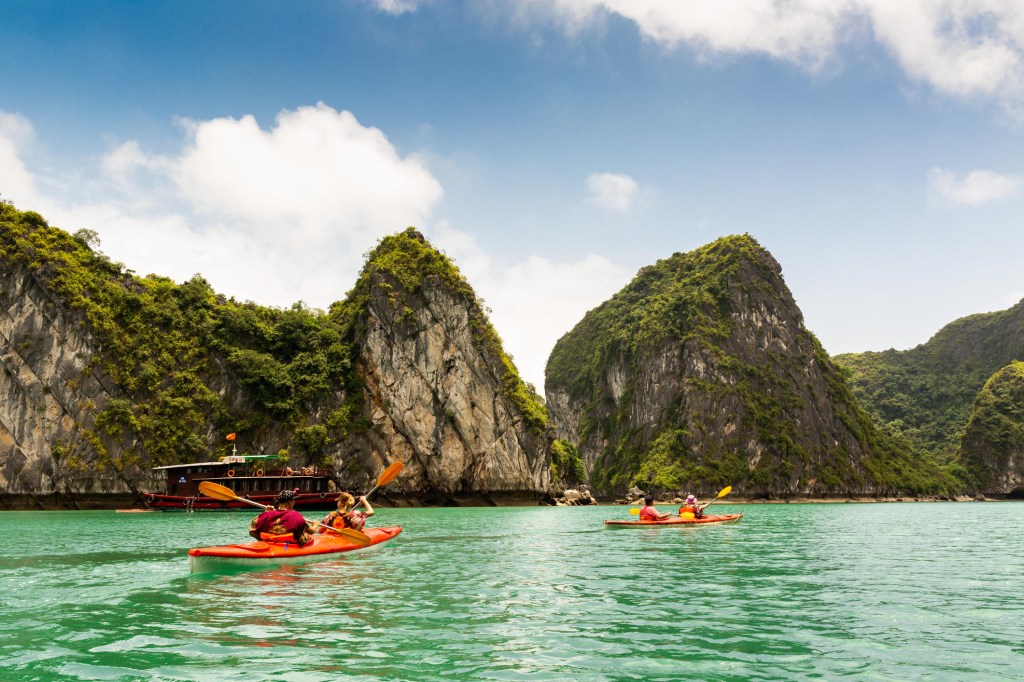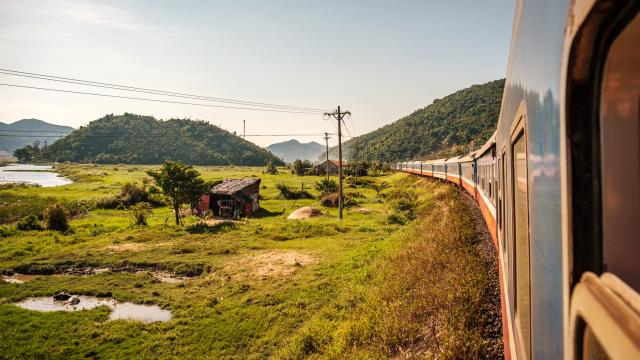Vietnam has become a favourite destination of Australian travellers thanks to its tempting food, complex history, and rich culture. Finding interesting places to visit and fun things to do isn’t going to be a challenge when planning a trip to Vietnam, but working out the best way to get to all the stops on your itinerary can be.
This is because there are many different ways to get about the country, each with its strengths and weaknesses. While you’ll probably need to mix and match depending on your plans, here are your best transport options for getting around Vietnam.
How to travel around Vietnam

Fly: Take to the skies
Vietnam is a deceptively large, or at least long, country which makes flying a convenient way to get around. Direct flights can get you from one city to the next within two hours, letting you maximise your time spent exploring your next destination.
The options for airlines serving domestic flights in Vietnam include the national carrier Vietnam Airlines and several budget airlines, namely Pacific Airlines and two newcomers, VietJet and Bamboo. Flying and its benefits of course comes with a cost, but prices are actually quite reasonable here, making it viable for most international travellers.
The obvious problem with relying on these short flights is their environmental impact, something you should take into consideration before booking a whole bunch of tickets. Studies show short-haul flights like these domestic routes have significantly larger carbon footprints per kilometre than long-haul flights.
Travel by train
If the idea of watching Vietnam’s landscape pass by your window appeals to you, then travelling by train in Vietnam might be the way to go. The country’s main train route runs all the way from Ho Chi Minh City to Hanoi, stopping at many of the most popular tourist destinations, while there are also specific regional lines such as the one from Hanoi to Lào Cai for people visiting Sapa.
Compared to the alternatives, train travel in Vietnam offers a gentle and relatively comfortable way to cover long distances. And while Vietnam’s trains don’t reach bullet train speeds, they’re not that much slower than travelling by bus and the cheapest fares aren’t much more expensive.
Train classes come with either seats or beds in sleeper cabins, with First Class equipped with four beds instead of Second Class’ six. Overnight trains are standard for longer journeys and for these, sleepers provide the best value, although light sleepers may get much shut-eye.
Bus it
The gold standard for backpackers travelling across Vietnam, buses are the go-to option for cheap and easy transport. But we’re not talking about local buses, which foreigners tend to avoid due to how full they get and how far you have to travel to reach their bus stations.
Instead, most travellers rely on open buses to travel the north-south route between Vietnam’s main destinations. Travellers will get either seated buses or sleeper buses, depending on the route, with sleeper buses mainly used for the long and often overnight journeys from one city to the next. Buses are outfitted with three rows of sleeper beds, each with two levels, letting you lie back and relax as you travel.
Open buses typically have USB ports for charging and even complimentary transfer services (shuttle or motorbike) from your accommodation to the bus. The reasonable prices for sleeper buses make them good value considering the distances they cover, just don’t necessarily expect a good night’s sleep.
Travel by motorbike
Travelling by motorbike is usually the best approach for exploring Vietnam independently. After all, motorbikes are the main means of transport for people in Vietnam because of their flexibility, availability and affordability.
This approach to travelling in Vietnam isn’t for everyone, though. You’ll definitely want to be a confident rider to handle city traffic, varying road conditions, and some potentially long days. Riding a motorcycle over 50cc in Vietnam requires a licence and you’ll also want to check what coverage your travel insurance provides for riding a motorbike.
To get your hands on a bike, you have two options – rent or buy. Travel agencies can set you up with a one-way bike rental and some even come with a luggage transfer, like the popular ride from Hue to Hội An over the scenic Hải Vân Pass.
Buying a bike is usually done by travellers planning to spend a long time in Vietnam or Southeast Asia. Foreigners are legally allowed to buy motorbikes in Vietnam, so some people buy a used bike at the start of their trip and sell it before leaving.
Cycling around Vietnam
One approach that appeals to a very specific kind of traveller is cycling in Vietnam. If you’re looking to combine visiting Vietnam’s destinations with a serious workout, then cycling can be a great way to add something more to your trip.
Certain parts of Vietnam are better suited to cycling than others. The mountainous areas of Northern Vietnam and the hills of the Central Highlands present a massive challenge, whereas much of the central coastline features long flat stretches, making it well-suited to touring by bicycle.
Cycling does come with limitations and dangers, from its slow pace to inherent road risks and the effects of tropical weather. To minimise the challenges of cycling, many people use organised cycling tours to help with moving luggage and logistics.
Take a car
Let’s just skip to the chase here – it’s very rare for tourists to travel around Vietnam by car. Independent travel is almost exclusively done by motorbike in Vietnam, meaning if you’re used to renting a car and driving yourself you’re probably out of luck.
Challenges on Vietnam’s roads include narrow alleys, heavy traffic, and difficulty parking, to name a few. Then there’s the matter of your driver’s licence. Per the Vietnam Embassy website, anyone operating a motor vehicle must first get a Vietnamese licence.
If you’re desperate for the flexibility of driving, then organising a private car service with a driver is the way to go. These services are usually only for shorter trips though, i.e. several days rather than a cross-country adventure, and come with an understandably high price tag.
Make your way by boat
While it won’t get you everywhere in Vietnam, there are more than a few places where you’ll find travelling by boat to be a common means of transport.
Hạ Long Bay is one, where to travel around the bay and reach its many islands you’ll sail in a junk – a traditional East Asian sailing ship. Similarly, there’s the Mekong River Delta, where boat travel is also a normal way to get around, even if it’s just paddling row boats through the delta’s network of waterways.
Travelling by boat can also just serve as a more leisurely way to get around. Flying to Phú Quốc may be the easiest way to get there, but modern ferries do run between the island and Hà Tiên on the mainland.

Leave a Reply
You must be logged in to post a comment.